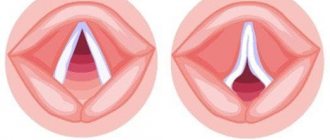Scientists suggest that the lack of free breathing through the nose shortens a person’s life. Why is it so important for the overall health of the whole body? The inhaled air, entering the nasal cavity, lined with the mucous membrane, travels a long path, along the entire length of which it is cleared of microparticles. Small bristly hairs - microcilia - trap larger fragments; The smallest particles stick to the mucus. Thus, the body cleanses itself of allergens, bacteria, viruses, and dust particles. In addition, the produced fluid contains special antibodies that help fight pathogenic microorganisms. Therefore, it is important that the mucous membrane constantly maintains its structure, and nasal breathing is not impaired.
It is clear that the problem of breathing through the mouth is always associated with nasal congestion or anatomical problems. If a child often has a stuffy nose, it is necessary to undergo an examination by an ENT doctor to find the cause of a chronic runny nose; treatment depends on this.
Do you have a baby?
A runny and stuffy nose is a particularly big problem for infants. Babies have very narrow nasal passages, and therefore rhinitis is not only very disturbing for them (sucking milk or breathing is a difficult choice!), It is also very dangerous for them. The main mistake of most parents is that instead of finding the cause of a runny nose, they try to eliminate a runny nose as a symptom! And if an infant has difficulty breathing through his nose, he should definitely show it to a doctor. Before consulting a specialist, you can only create optimal conditions for comfortable breathing, namely: reduce the room temperature to 20 degrees and humidify the air.
Adenoids?
Adenoids (a long-term inflammatory process in the nasopharynx, which is accompanied by an increase in the adenoid tissue of the tonsils) is the most common cause of impaired nasal breathing in children.
The cause of adenoids is “malfunctions” in the functioning of the endocrine or lymphatic system. An increase in adenoid tissue usually occurs during an infectious disease (scarlet fever, measles, etc.). By puberty, the problem usually goes away on its own. However, you shouldn't wait until adolescence. Adenoids greatly affect the quality of life and affect the general condition: the baby may develop the usual “apathetic” facial expression, the timbre of the voice will be distorted and the appetite will decrease. In especially advanced cases, pathological development of the chest and anemia may occur. The decision about surgical removal can only be made by a doctor; only he can competently assess the size of the adenoids and nasopharynx and the degree of danger.
Painful enlargement of the tonsils?
The same applies to the palatine tonsils - do not expect spontaneous recovery. Although some doctors advise starting treatment only when the general condition of the body worsens, since sometimes a simple enlargement of the tonsils, not accompanied by other symptoms, indicates that the body is fighting the infection on its own.
If a child has chronic inflammation and enlarged tonsils, he should definitely be seen by an ENT doctor. In such cases, it is also often necessary to resort to surgery. However, this can provoke an increased predisposition to acute respiratory diseases and weakened immunity, so the degree of risk can only be assessed by a specialist
Ways to solve the problem
First you need to show your child to a doctor and conduct a comprehensive examination:
- The initial task is to eliminate the infection. The doctor may prescribe antibiotics. They are selected individually.
- Rinsing with antiseptic solutions helps.
- Irrigation of the mucous membranes with drugs with an anti-inflammatory effect may also be prescribed.
- Dragees, tablets, lozenges relieve swelling and sensations of discomfort and pain.
- Immunity is increased by taking multivitamin complexes.
It is very important to fully treat ENT diseases. For this purpose, an individual therapeutic program is drawn up. Parents need to understand that for preschool children, most often, but not in every case, surgical measures are not carried out for overgrown lymphoid tissues, since they return to normal on their own at the age of seven. But the decision is made by the doctor in each individual case.
Among the basic recommendations that parents should follow to rid their child of tonsillitis are:
- Bed rest for at least 3 days
- Mucosal-friendly nutritious diet
- Warm and plenty of fluids
- We must not forget about ventilating the room and humidifying the air in it.
- If tonsillitis is caused by fungi, special antifungal therapy is prescribed
To reduce the intensity of snoring with sore throat, doctors often prescribe moisturizing and cleansing solutions. They wash the throat and nasal passages. Decongestants and vasodilators also work well against rhonopathy in children.
ARVI? Seasonal allergic rhinitis (hay fever)?
Often, a child suffering from rhinitis does not have other clear symptoms that would force parents to see a doctor. However, by not paying due attention to this condition, adults doom the child to possible complications. A prolonged runny nose will require more serious treatment. Due to a constant lack of oxygen, chronic oxygen starvation (hypoxia) or anemia may occur, as a result, the immune system will weaken, headaches may begin, and increased fatigue and irritability may appear. And an untreated runny nose can cause overgrowth of adenoids, sinusitis, decreased hearing acuity and repeated otitis media.
If the cause of difficulty breathing is swelling of the mucous membrane, decongestants can help solve the problem. The new generation spray Rinomaris ® contains not only the vasoconstrictor xylometazoline, but also sea water. Xylometazoline begins to act within a few minutes after use, eliminating nasal congestion for up to 12 hours. The Adriatic Sea water solution moisturizes and protects the mucous membrane and thins nasal mucus. By normalizing the production of mucus and preventing its thickening, sea water reduces the risk of the spread of microorganisms into the cavities adjacent to the nose, thus reducing the risk of developing inflammatory complications of the runny nose, primarily sinusitis and otitis media.
How is mouth breathing treated in children?
The approach to the treatment of oral breathing must be comprehensive - that is, it cannot solely be the correction of malocclusion through the efforts of the orthodontist. Ideally, a set of measures should be aimed at:
- correcting the position of the tongue in the mouth;
- formation of a competent chewing and swallowing reflex;
- developing correct posture.
Otherwise, everything will return to where it started. It is very important to solve the problem comprehensively, getting to and eliminating the causes of its occurrence. Only after the child begins to breathe through his nose again does it make sense to form a normal bite with the help of trainers or braces.
If we talk about osteopathy, osteopathic doctors use a myofunctional approach - therapy based on therapeutic exercises and the literal “retraining” of facial muscles or the creation of correct movement patterns. In addition, certain effects are exerted directly during the sessions, namely:
- effects on the bone structures that form the oral and nasal cavities;
- relieving excess tension from the muscles of the neck, face, head, bottom of the mouth, or, on the contrary, strengthening weakened areas, restoring tone;
- release of the initially compressed hypoglossal nerve, due to which motor innervation of the tongue occurred.
Appointments with an osteopath, together with therapeutic exercises and - subsequently - correction of the bite through the efforts of an orthodontist, will allow the child to acquire a physiologically correct bite and get rid of many problems, including in the future.
It is impossible to describe in words how closely the bite is connected with posture, with the condition of the musculoskeletal system, as well as with the nutrition of internal organs and especially the brain.
If the child does not breathe through his nose, under no circumstances should he
- warm your nose (without a doctor’s recommendation). This may cause unwanted complications
- drip concentrated liquids into the nose (kalanchoe or onion juice, for example). May cause burns to mucous membranes
- drip vasoconstrictor drops for longer than five days. Addiction may occur and, as a result, the need to increase the dosage and frequency of administration to achieve the desired effect
It happens that the causes are eliminated, but the habit of breathing through the mouth remains. Remind your child how to breathe correctly, in simple words tell him about the structure of the nasopharynx, about the eyelashes that work non-stop to clear the nasopharynx, about the slightly nasty but very useful nasal mucus... It is important to teach a little person to be attentive to his health from childhood!
- Breath
- Swallowing
How to breathe correctly? Why is mouth breathing harmful to bite formation? Why breathe through your nose?
Proper breathing is the key to health. The nose is the most important organ that ensures a stable level of oxygen supply to all body systems. The air inhaled through the nose, passing through the nasal passages, is moistened, heated, cleared of dust that settles on the hairs in the nose, and partially neutralized from germs.
When air enters the nasal passages, the receptors that participate in the regulation of blood flow are irritated, and the centers of the brain are stimulated.
Also, some oxygen (O2) is absorbed into the blood through the nasal mucosa.
When breathing through the nose during rest: the mouth is closed, the teeth are slightly unclenched (2-3 mm), the lips are closed, but without tension, the tongue takes its correct position, namely: the tongue is raised to the palate, the tip of the tongue is adjacent to the palatal surface of the upper front teeth jaws. In this position, the tongue muscles counteract the cheek and masticatory muscles - this is called myodynamic balance.
When breathing through the mouth, the myodynamic balance of the maxillofacial area is disrupted: in order for a stream of air to pass into the pharynx, the tongue lowers and is between the dentition - this increases the tone of the muscles that lower the lower jaw and shift it back, and this leads to the formation of a distal bite. In an incorrect position, the tongue does not support the arch of the upper jaw and does not balance the pressure of the cheek muscles on the dentition. As a result, the child experiences a narrowing of the upper jaw, and there is not enough space for the eruption of all permanent teeth. Reduced tone of the orbicularis oris muscle leads to protrusion of the anterior part of the upper jaw, tilting of the upper front teeth, and the negative pressure created in the nasal cavity causes the formation of a high (“Gothic”) palate, negatively affecting sound pronunciation.
In addition to influencing the formation of the bite, mouth breathing has an adverse effect on the formation of the profile, significantly affecting the aesthetics of the face.
What are the causes of mouth breathing?
- Mechanical obstruction in the upper respiratory tract (adenoids, polyps, deviated nasal septum)
- Swelling of the nasal mucosa associated with frequent inflammation or allergies
- Insufficient function of the orbicularis oris muscle, that is, the lips
- The habit of breathing through the mouth - a common mistake is the assumption that after removal, for example, of the adenoids, the child will begin to breathe through the nose on its own - this must be learned even after removing obstacles
- Abnormalities in the position of the teeth or bite, in which it is impossible to close the lips completely
What are the signs of mouth breathing?
- The upper lip is upturned
- Constantly open mouth
- Elongated oval face
- Frequent runny nose, colds
- The child often licks dry lips
- The child sleeps with his mouth open and sometimes snores
How does a child's profile change during mouth breathing?
- Convex profile
- Wide bridge of nose
- Narrow nostrils that do not participate in the act of breathing
- Flattening of the infraorbital areas
- Double chin
What should you do if your child constantly breathes through his mouth?
It is imperative to visit two specialists: an ENT doctor and an orthodontist.
Advice to parents: do not prescribe these devices to your children without a doctor’s recommendation, even if you can buy them over the counter.
|
orthodontist Antonina Fartushnaya










